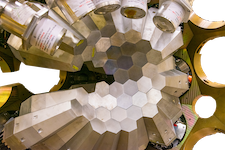Speaker
Description
The $^{14}$N($p,\gamma$)$^{15}$O is the slowest reaction in the CNO cycle and thus regulates both the rate of the energy production and the nucleosynthesis in stars more massive than our Sun. Additionally, it has a crucial impact on the flux of the solar CNO neutrinos, recently measured at Borexino. Nevertheless, the reaction rate at astrophysical energies is poorly constrained due to the uncertainty in the width of the subthreshold resonance located at $E_{r} = -504$ keV, corresponding to the $E_{x} = 6.793$ MeV state in $^{15}$O, which dominates the extrapolations at lowest energies.
One of the methods to obtain the width of a subthreshold resonance is the measurement of its lifetime. Since the expected lifetime of the $6.793$ MeV state is of the order of $1$ fs, the only technique that can be employed is the Doppler Shift Attenuation Method (DSAM). Several studies have used this approach in the past, but none of them were able to obtain a lifetime precise enough to properly constrain the extrapolations. The lifetime, in fact, lies at the edge of DSAM applicability. Nevertheless, by using a HPGe tracking array alongside a segmented silicon detector, the DSAM sensibility can be pushed down to $0.1$ fs. This would permit a precise lifetime measurement of the $6.793$ MeV state and put a hard constrain on the reaction rate of the $^{14}$N($p,\gamma$)$^{15}$O at astrophysical energies.
For these reasons, we propose to use the AGATA array coupled with a highly segmented silicon detector (TRACE,SPIDER, or annular). The $^{16}$O($^{3}$He,$^{4}$He)$^{15}$O reaction in inverse kinematics will be used to produce the $^{15}$O in the desired excited state. The targets will be made by implanting $^{3}$He in Au backings and the beam will be provided by the TANDEM accelerator at LNL.

